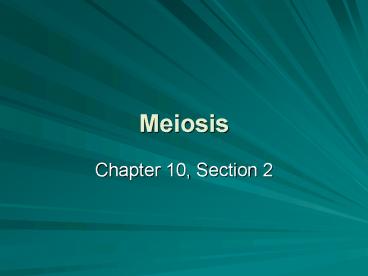Meiosis PowerPoint PPT Presentation
1 / 26
Title: Meiosis
1
Meiosis
- Chapter 10, Section 2
2
Meiosis Activity
- You need one textbook for every two students and
a sheet of paper with both your names on it. - You will be taking notes from the screen and
using your textbook.
3
Genes and Chromosomes
- Punnett squares help us to study a few genetic
traits at a time - Organisms actually have tens of thousands of
genes that make each of us unique - Genes are lined up on chromosomes
- One chromosome can contain a thousand genes along
its length
4
Turn to page 265 in the textbook
- Take a sheet of paper and put both your names on
it. With your partner, find the bold word
meiosis. Read about meiosis and answer the
following questions. - 1. Does meiosis occur in liver, heart, and skin
cells? - 2. Why is it important for organisms to produce
cells with HALF the number of chromosomes?
5
Diploid Haploid Cells
- Diploid a cell with two sets of chromosomes, 2n
- Haploid a cell with one set of chromosomes,
gametes, 1n - Meiosis forms haploid gametes required for sexual
reproduction - Meiosis has 2 stages
- Meiosis I
- Meiosis II
6
Turn to page 265
- Study Table 10.1 Chromosome Numbers of Common
Organisms and answer the following questions with
your partner. Be prepared to share your answers. - 3. What does the n stand for in the table?
- 4. Look at the data for the leopard frog. Why is
the number in the body cell column double the
number in the gamete column?
7
? MEIOSIS I
- Separation of homologous pairs
- Homologous Pair in a diploid cell the 2 sets of
chromosomes pair up
8
? 1. Prophase I
- DNA coils into chromosomes
- Nuclear envelope nucleolus break down
- Synapsis homologous chromosomes pair up into
tetrads - Crossing-over homologous pairs switch pieces of
their chromatids - Genetic Recombination maternal paternal
genetic info get shuffled during crossing-over
9
(No Transcript)
10
Turn to page 269
- Study Figure 10.13 and answer the following
questions. Be prepared to share your answers! - 5. Are sister chromatids identical or different
to each other? What about homologous pairs? - 6. In part C, if you put the four chromosomes
back into pairs, would they be the same as the
original Homologous chromosomes in part A?
11
? 2. Metaphase I
- Tetrads line up in the middle of the cell
- Spindle fibers attach at the centromeres of each
homologous chromosome
12
Homologous chromosomes line up sideby side as
tetrads
13
? 3. Anaphase I
- Each homologous chromosome moves to the opposite
end of the cell - Independent Assortment random separation of
chromosomes, allows for genetic variation
14
(No Transcript)
15
? 4. Telophase I Cytokinesis I
- Two newly formed cells are haploid
- Each chromosome is still made up of two
chromatids
16
2 Non-Identical Cells Created
17
- Humans have 46 chromosomes (23 pairs)
- 7. With your partner, discuss what would happen
if the formation of gametes stopped after meiosis
I. How many chromosomes would the resulting human
end up with? Be prepared to share with the class!
18
? MEIOSIS II
- Separation of sister chromatids
- Sister Chromatids identical halves of a
chromosome that has been duplicated
19
? 5. Prophase II
- 2 newly created cells from Meiosis I start to
divide
20
? 6. Metaphase II
- Chromosomes line up in the center
21
? 7. Anaphase II
- Sister Chromatids separate
22
? 8. Telophase II Cytokinesis II
- 4 new cells, each with half the number of
chromosomes of the original cell
23
Development of Gametes
- Spermatogenesis production of sperm cells
- Oogenesis production of mature egg cells
24
Turn to page 269
- Read the section titled Meiosis Provides for
Genetic Variation and answer the following
questions - 8. Describe the major difference between cells
formed by mitosis and cells formed by meiosis. - 9. What is variability mean in meiosis and why
is it important to us?
25
Nondisjunction
- Nondisjunction failure of homologous pairs to
separate in Meiosis I - If an organism survives, it may have a genetic
disorder
26
Polyploidy
- Polyploid organisms with more than the usual
number of chromosome sets - Occurs frequently in plants, results in plants
that are larger than normal

